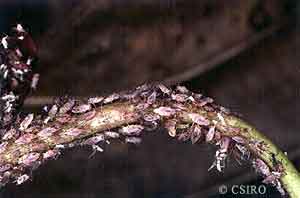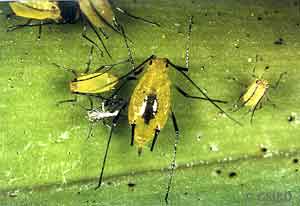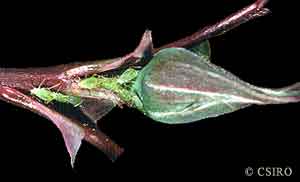
|
APHIDIDAE Aphids |
|
| ||||||||||||
|
Aphids are familiar to most people especially home gardeners whose roses, fruit trees or other small crops have been attacked at one time or another. Aphids are small soft-bodied bugs with long thin antennae. Some individuals may have wings while others are wingless.
Aphids are sap-sucking insects and produce honeydew as a waste product. Ants are often attracted by this honeydew and in turn offer the aphids a measure of protection in order to keep the production of honeydew going.
Aphids often live on one plant for their whole life cycle and can build up in large numbers as generation after generation hatch, grow and die on the same plant. Some aphids attack agricultural crops as well as ornamental plants causing stunted growth and carrying viruses, passing them from plant to plant as they feed. The oat aphid, Rhopalosiphum padi is known to transmit several virus diseases to a number of cereal crops.
There are thousands of species of aphids in the world and many of these feed specifically on one plant species. An example of this is Macrosiphum rosae, the rose aphid. These small, soft bodied aphids are possibly the biggest enemy of the home gardener as they feed on sap in the tender growing tips and buds of rose plants. This feeding causes wilting, stunted growth and reduces the quality and quantity of blooms. Most populations are small and cause little damage as they are often kept under control by natural predators. Parasitic wasps, lady beetles and the larvae and adults of green lacewings all feed on rose aphids. Rose aphid populations are capable of building to very large numbers over a relatively short period of time. Eggs hatch in spring and develop into females that are capable of producing live young. At this time only female aphids are produced and many generations will be born over the warmer months. Towards the end of summer the aphids begin to give birth to both males and females who mate and lay eggs. The eggs overwinter and hatch the following spring to begin the life cycle again. For more aphid species visit the Australian Insect Common Names |


